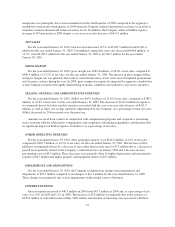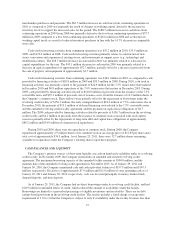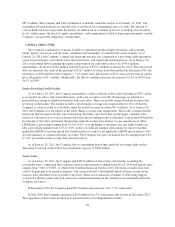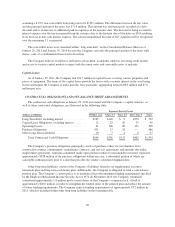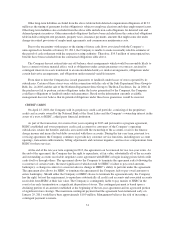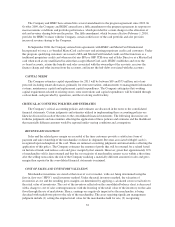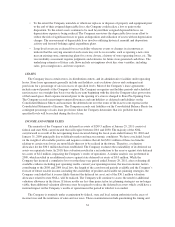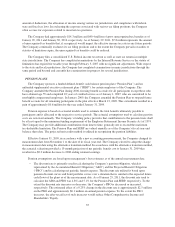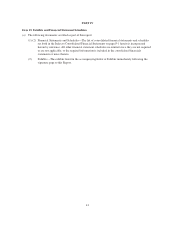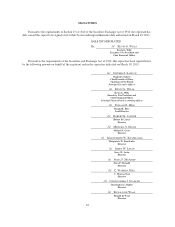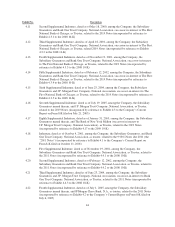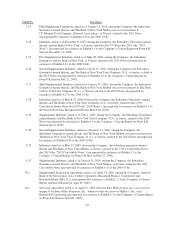Saks Fifth Avenue 2010 Annual Report Download - page 36
Download and view the complete annual report
Please find page 36 of the 2010 Saks Fifth Avenue annual report below. You can navigate through the pages in the report by either clicking on the pages listed below, or by using the keyword search tool below to find specific information within the annual report.amount of deductions, the allocation of income among various tax jurisdictions and compliance with federal,
state and local tax laws. In evaluating the exposure associated with various tax filing positions, the Company
often accrues for exposures related to uncertain tax positions.
The Company had approximately $14.3 million and $40.4 million of gross unrecognized tax benefits as of
January 29, 2011 and January 30, 2010, respectively. As of January 29, 2011, $7.8 million represents the amount
of unrecognized tax benefits that, if recognized, would impact the effective income tax rate in any future periods.
The Company continually evaluates its tax filing positions and to the extent the Company prevails on audits or
statutes of limitation expire, the unrecognized tax benefits could be realized.
The Company files a consolidated U.S. Federal income tax return as well as state tax returns in multiple
state jurisdictions. The Company has completed examinations by the Internal Revenue Service or the statute of
limitations has expired for taxable years through February 3, 2007 with no significant adjustments. With respect
to the state and local jurisdictions, the Company has completed examinations in many jurisdictions through the
same period and beyond and currently has examinations in progress for several jurisdictions.
PENSION PLANS
The Company sponsors a funded defined-benefit cash balance pension plan (“Pension Plan”) and an
unfunded supplemental executive retirement plan (“SERP”) for certain employees of the Company. The
Company amended the Pension Plan during 2006, freezing benefit accruals for all participants except those who
have attained age 55 and completed 10 years of credited service as of January 1, 2007, who are considered to be
non-highly compensated employees. In January 2009, the Company amended the Pension Plan to suspend future
benefit accruals for all remaining participants in the plan effective March 13, 2009. This curtailment resulted in a
gain of approximately $0.6 million for the year ended January 31, 2009.
Pension expense is based on actuarial models used to estimate the total benefits ultimately payable to
participants and is allocated to the respective service periods. The actuarial assumptions used to calculate pension
costs are reviewed annually. The Company’s funding policy provides that contributions to the pension trusts shall
be at least equal to the minimum funding requirement of the Employee Retirement Income Security Act of 1974.
The Company may provide additional contributions from time to time, generally not to exceed the maximum
tax-deductible limitation. The Pension Plan and SERP are valued annually as of the Company’s fiscal year-end
balance sheet date. The projected unit credit method is utilized in recognizing the pension liabilities.
Effective January 31, 2009, in accordance with a new accounting pronouncement, the Company changed its
measurement date from November 1 to the date of its fiscal year end. The Company elected to adopt the change
in measurement date using the alternative transition method. In accordance with the alternative transition method,
the actuarial valuation provided a 15-month projection of net periodic benefit cost to January 31, 2009 that
resulted in a $0.3 million decrease to 2008 ending retained earnings.
Pension assumptions are based upon management’s best estimates as of the annual measurement date.
• The discount rate is primarily used in calculating the Company’s pension obligation, which is
represented by the Accumulated Benefit Obligation (“ABO”) and the Projected Benefit Obligation
(“PBO”) and in calculating net periodic benefit expense. The discount rate utilized is based upon
pension discount curves and bond portfolio curves over a duration that is similar to the expected future
cash flows of the plans as of the measurement date. As of January 29, 2011, the discount rate used to
calculate the ABO and PBO was 4.8% and 5.1% for the Pension Plan and SERP, respectively. To the
extent the discount rate increases or decreases, the Company’s PBO is decreased or increased,
respectively. The estimated effect of a 0.25% change in the discount rate is approximately $2.5 million
on the PBO and approximately $0.1 million on annual pension expense. To the extent the PBO
increases, the after-tax effect of such increases would reduce Other Comprehensive Income and
Shareholders’ Equity.
35


